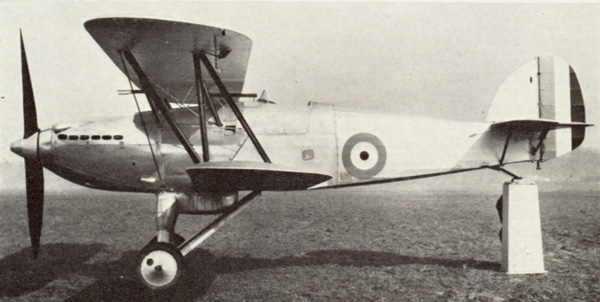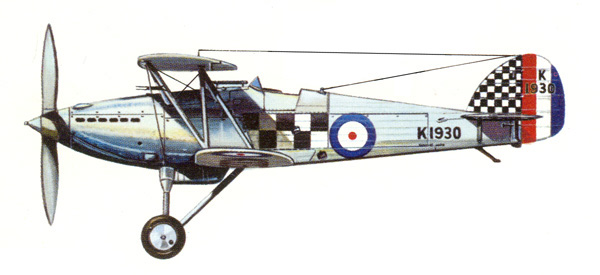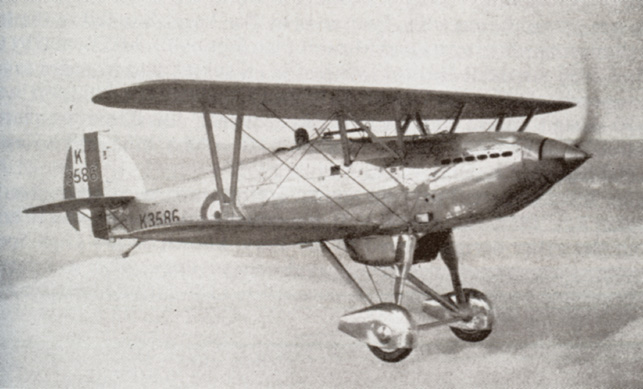
|
 |
Hawker Fury |
 |
 |
 |
 |
 |
|---|---|---|---|---|---|---|---|
 |
 |
 |
 |
 |
|||

|
||
|
Developed independently, the Hawker Fury was considered somewhat of a face-saver for the RAF, as the recent introduction of the 184 mph Hawker Hart bomber was faster than the just newly adopted, 174 mph Bristol Bulldog defensive fighter. Above is the true Hawker Fury Prototype, the Hornet.
| ||
| After development of the immensely successful series of Hawker Hart light bombers, aircraft designer Sydney Camm developed a similar but related fighter development, initially known as the Hornet. The Hornet was initially powered by a 420 hp in-line liquid cooled Rolls Royce F.XIA engine, and was almost immediately modified to take the 480 hp F.XIS engine. Even with the use of an early developmental engine, the Hornet demonstrated impressive results with speeds over 200 mph. The new engine, soon to be known as the Kestrel1, featured a major advance in engine technology with the introduction of a pressurized cooling system.2 |
| The Hornet was one of the highlights of the 1929 Olympia Aero Show, and this was the first public appearance of the prototype. It was after this event, when it was delivered as J9682 in 1930 to Martelsham Heath for flight testing. Pilots were impressed with the aircraft's rapid climb, high maximum speed, and impressive maneuverability. The Hornet's superior handling qualities, and great structural strength, prompted the RAF to issue an order for twenty-one Fury Is. A tour of the aircraft to the Balkans in early 1931, sparked interest in the type, which subsequently led to an initial order of six Furies by Yugoslavia.3 |
| Tests at Martelsham Heath demonstrated that the Hornet, capable of reaching 207 mph in level flight,4 was superior to the Bristol Bulldog, which had just been ordered in extensive quantities for the RAF. The Bristol Bulldog created somewhat of a dilemma for the RAF as the Hart bomber could reach speeds up to 184 mph, while the Bristol Bulldog's maximum speed was only 174 mph.5 During military exercises, the Hart bomber squadrons could complete their mission, while virtually undisturbed by fighter defense. The superior performance of the Hart bomber now invalidated provisions of the F.20/27 requirements, and they were extensively rewritten around the potentialities of the Kestrel engine.6 |

|
|
|
Hawker Fury I flown by the Commanding Officer of RAF Squadron No 43, Tangmere, early 1932.
| |
|
Adopting the RAF policy of naming fighters with words beginning in "F", the Fury as it was now known, went into only limited production, even though it was a superior performing aircraft. The aircraft's relatively high cost (compared to the Bulldog) and economic conditions caused by the Great Depression, were factors that attributed to modest orders of production aircraft. Initially, the Fury equipped No, 43 Squadron at Tangmere in May 1931 and later serving with No. 1 and No. 25 Squadrons, the RAF's corps d'elite.7 Later, a few served with various training establishments.
Fundamentally, the Fury was a relatively small, single seat biplane fighter with an airframe incorporating a newly advance design of tubular steel and aluminum for the fuselage and dumb-bell wing spars, which would remain features of all Hawker aircraft well into WWII.8 Unlike the Hart there was no wing sweepback and ailerons were installed only on the top plane. All versions had a span of thirty feet, while Kestrel variants were 26 feet 8 inches long, with radial engine variants being slightly shorter. Standard armament was installed, comprising of twin Vickers .303 inch guns, with 600 rounds per gun. Performance varied with the powerplant installed, with Kestrel powered variants exceeding the 200 mph mark, while some of the lower powered radial engine types were slightly slower. It was the last classic liquid-cooled engine fighter biplane in the RAF and subsequent replacements including the Gloster Gauntlet and Gloster Gladiator. Only 118 Furies were produced for the RAF, but approximately thirty-two were exported. |

|
|
|
The High Speed Fury with Kestrel VI S engine, tapered wing and vee interplane struts.
| |
|
British variants included the Fury I, the Fury II, the Intermediate Fury and the High Speed Fury. The Intermediate Fury, registered as G-ABSE, was used as a testbed to meet Specification F.7/30,9 and led the development of the P.V.3. The Intermediate Fury was first quipped with a Kestrel IIS engine, wheel pants and Messier oleo struts. By the end of 1932, a Kestrel IVS was installed in order to test the supercharger for the Goshawk engine. Other engine installations tested were a Kestrel VI in October 1933, a Goshawk III in May 1935 and Kestrel Special (upgraded Kestrel VI) in August 1935. The High Speed Fury, which featured tapered wings, modified "V" struts, also tested a variety of engines. Engine installations were a 525 hp Kestrel IIS, a 600 hp Kestrel S (Special), a 525 hp Kestrel IIIS, a 600 hp Kestrel VIS, a 695 hp Goshawk III and a Goshawk B.41.10
Perhaps the more interesting Furies were the export versions. Standard production Furies were exported to Yugoslavia, Norway, Persia, Spain and Portugal. In addition, some ex-RAF aircraft went to South Africa, where they were used against the Italians during World War II. Yugoslavia produced about 40 modified Furies with cantilever landing gear and more powerful engine, and some of these wound up with the Spanish Republicans, and when the war was over, the Franco government. Some ex-Yugoslav Furies were used by the Italians as fighter trainers with mixed markings. The Persian Furies had Pratt & Whitney Hornet radials, but these were later replaced by Bristol Mercury engines for added performance. So favored were the Persian Mercuries by their pilots, they were flown as late as 1943. The only Norwegian Fury, No. 401, used an Armstrong Siddeley Panther IIIA radial engine, however the results proved disappointing as the engine installation moved the c.g. forward resulting in a tendency of the airplane to nose over during taxiing. The Persian Hornet variants, installed with a metal Hamilton 3-blade propeller, also exhibited the same c.g. problems.11 Three Spanish Furies with Hispano-Suiza 12XBrs engines were ordered in 1935 and first flown in April 1936. They arrived in Spain July 11,1936 just one week before the start of the Spanish Civil War. Two (4-1, 4-2) were flown by Republican forces and one (4-3) was flown by the Nationalists. At least one of the aircraft changed hands several times, 4-3 being used as a dive bomber until it was destroyed in 1938.12 Notwithstanding the low production figures, the Fury I will always be considered a classic fighter biplane. |
| Hawker Fury I |
Specifications: |
|---|---|
| Dimensions: | |
| Wing span: | 30 ft (9.14 m) |
| Length: | 26 ft 8 in (8.12 m) |
| Height: | 10 ft 2 in. (3.09 m) |
| Wing Area: | 252 sq. ft. (76.80 sq. m) |
| Weights: | |
| Empty: | 2,623 lb. (1,189 kg) |
| Max Gross: | 3,490 lb (1,583 kg) |
| Performance: | |
| Max Speed: | 207 mph (333 km/h) at 14,000 ft (4,267 m) |
| Climb Rate: | 4 min. 25 sec. to 10,000 ft. (3,048 m) |
| Ceiling: | 28,000 ft. (8,534 m) |
| Normal Range: | 305 miles (490 km) |
| Powerplant: | |
|---|---|
|
Rolls Royce Kestrel IIS, 525 hp (391 kW) for TO, 12 cyl., vee, liquid cooled engine, driving a 2 blade, Watts wooden propeller. |
|
| Armament: | |
|
Standard upper front fuselage 0.303 in. Vickers machine-guns with 600 rounds per gun. |
|
| Endnotes |
|---|
|
1. Herschel Smith. The History of Aircraft Piston Engines. Manhattan, Kansas; Sunflower University Press, 1986. 75. 2. Wikopedia. Rolls-Royce Kestrel 3. Francis K. Mason. Hawker Aircraft Since 1920. Annapolis, Maryland; Naval Institute Press., 1991. 196. 4. Francis K. Mason. Aircraft In Profile. The Hawker Fury. Surrey, England; Profile Publications Ltd., 1965. 4. 5. Ibid. 3. 6. Mason. 192. 7. Kenneth Munson. Fighters Between the Wars, 1919-39. New York, The Macmillan Company, 1960. 124. 8. Paul Gallico. The Hurricane Story. Garden City, NY; Doubleday & Company, 1960. 19,26. 9. Mason. 200. 10. Ibid. 202. 11. Ibid. 199. 11. Ibid. 207. |
| Other Sources |
|
1. Michael J.H. Taylor and John W.R. Taylor, ed. Encyclopedia of Aircraft. New York; G.P. Putnam's Sons., 1978. 119,121. 2. Iain Parsons, ed. The Encyclopedia of Air Warfare. New York; Thomas Y. Crowell Company., 1975. 52. 3. Michael J.H. Taylor, ed. Jane's Encyclopedia of Aviation. New York; Crescent Books., 1989. 485-486. 4. Michael Sharpe. Biplanes, Triplanes and Seaplanes. New York; Barnes & Noble Inc., 2000. 221-232. 5. Jean Alexander, Chaz Bowyer, Roger Freeman, Bill Gunston, A.J. Jackson, Bruce Robertson, & Rodney Steel, ed. Encyclopedia of Aircraft. New York; Charles Scribner's Sons., 1977. 80. |
©Larry Dwyer The Aviation History On-Line Museum.
All rights reserved.
Created February 25, 2007. Updated November 9, 2014.